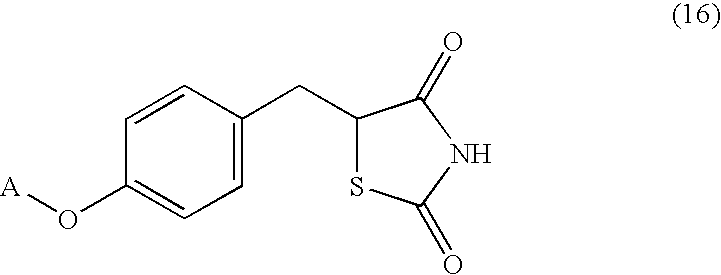Processes for making thiazolidinedione derivatives and compounds thereof
a technology of thiazolidinedione and thiazolidinedione, which is applied in the direction of drug compositions, bulk chemical production, metabolism disorders, etc., can solve the problems of complex reaction, complicated outcome, and difficulty in forming alpha-bromo acid ester by meerwein arylation reaction
- Summary
- Abstract
- Description
- Claims
- Application Information
AI Technical Summary
Benefits of technology
Problems solved by technology
Method used
Image
Examples
preparation 1
N-acetyl-L-tyrosine (Compound (12A), Z=acetyl)
18.1 g of L-tyrosine was mixed with 100 mL of water, the mixture was heated to 90-95° C., and 85 mL of acetic anhydride was added dropwise during 2 hours. The light yellow solution was evaporated in a vacuum to give 28.5 g of an oily residue, mixed with 100 mL of acetone, boiled for a few minutes, and the unreacted L-tyrosine was removed by filtration. The filtrate was evaporated in a vacuum, dissolved in 60 mL of 1,4-dioxane. The resulting yellow solution was stirred and seeded. Precipitated crystals were filtered off, air-dried (18.5 g), and recrystallized from tetrahydrofuran.
preparation 2
N-acetyl Tyrosine Ethyl Ester (Compound (12B), Z1=ethyl, Z2=acetyl)
24.6 g of tyrosine ethyl ester hydrochloride was dissolved in 200 ml of dichloromethane. Under cooling (ice-water bath), 20.2 g of triethylamine was added and followed by slow addition of 10.3 g of acetic anhydride. The reaction mixture was further stirred for 1 hour at the same temperature. 200 ml of water was added, and the mixture was stirred for 30 minutes. The resulting layers were separated. In particular, the aqueous layer was extracted with 200 ml of dichloromethane. The organic layers were combined and dried over sodium sulfate and concentrated in a vacuum to give 29.3 g of an oily product.
preparation 3
2-(5-ethyl-pyridin-2-yl)-ethyl Methanesulfonate
30.2 g of 2-(5-ethylpyridin-2-yl)ethanol was dissolved in 300 ml of toluene. Under cooling in an ice water bath, 20.2 g of triethylamine was added followed by slow addition of 22.9 g methane sulfonylchloride. After completion of the addition (30 minutes), the reaction mixture was stirred for 1 hour at approx. 3° C. The reaction mixture was washed with 2×100 ml of water, 50 ml of brine, and dried over sodium sulfate.
The obtained toluene solution was used for subsequent synthesis.
In some cases, as discussed below, 100 ml of the solution was evaporated to obtain an oily product (14.02 g).
PUM
 Login to View More
Login to View More Abstract
Description
Claims
Application Information
 Login to View More
Login to View More - R&D
- Intellectual Property
- Life Sciences
- Materials
- Tech Scout
- Unparalleled Data Quality
- Higher Quality Content
- 60% Fewer Hallucinations
Browse by: Latest US Patents, China's latest patents, Technical Efficacy Thesaurus, Application Domain, Technology Topic, Popular Technical Reports.
© 2025 PatSnap. All rights reserved.Legal|Privacy policy|Modern Slavery Act Transparency Statement|Sitemap|About US| Contact US: help@patsnap.com



